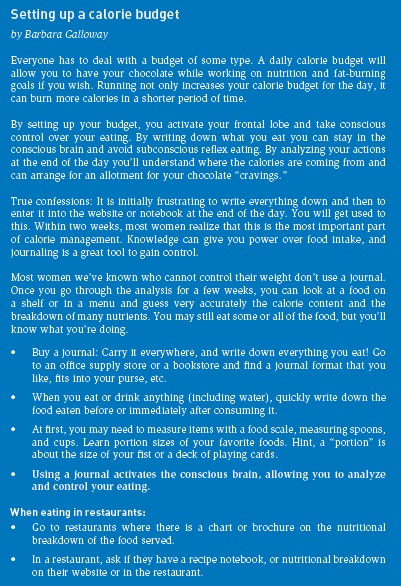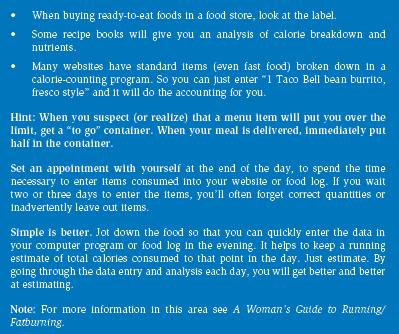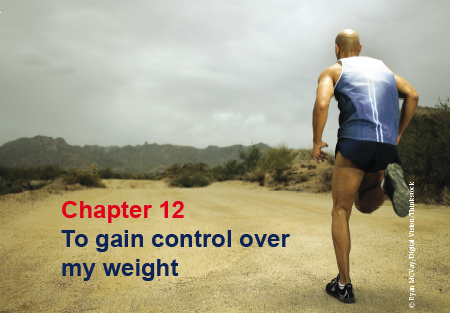

| 97 | Do I run to eat or eat to run? |
We’ve targeted one of the basic philosophical issues of running. Whatever side you choose, on any given day, you can win both ways if you set up a strategy. Food offers the energy we need for running and the timing of food intake can improve or detract from your workouts. Gentle, aerobic running will stimulate appetite, but it will also trigger the burning of fat. Here’s how it works.
Our subconscious brain has many behavioral eating patterns that were set up more than a million years ago. Long before our ancestors discovered how to use tools or to strategically hunt, they survived by moving constantly and gathering bits of food. Starvation was common. Our digestive tracts are set up to store potential energy in the form of fat when food is available by significantly delaying the production of hormones that leave one feeling satisfied after big meals. Our reflex brain makes sure that we have enough reserve fuel on board for extended periods of starvation. However, it does its job too well.
Our bodies were designed to exercise and work better in every area when we get our daily exertion. Those who are under a high level of stress find that a correctly paced workout reduces stress. But when we don’t move around and burn enough calories, the stress builds up and triggers a number of negative subconscious behavior patterns.
Surprisingly, scientists have found that when we don’t burn the minimum calories we are programmed to burn, our appetite is stimulated and we tend to get into a pattern of reflex eating that triggers a powerful neurotransmitter, dopamine. Research shows that very sedentary people eat more than very active people, and they feel more tired and less motivated. By moving ourselves around for a few miles a day (running or walking), we activate systems that can keep appetite and energy in balance.
There’s an excellent sourcebook by Robert Portman and John Ivy called Hardwired for Fitness. It shows how the various circuits in your reflex subconscious brain function and how you can work in harmony with your needs.
For 30-40 minutes after a run, you turn on a switch in your brain that can maximize the reloading the glycogen used during the run. Eating a snack of 100-300 calories, composed of 80% simple carbohydrates (sugar) and 20% protein, will help reload the muscles.
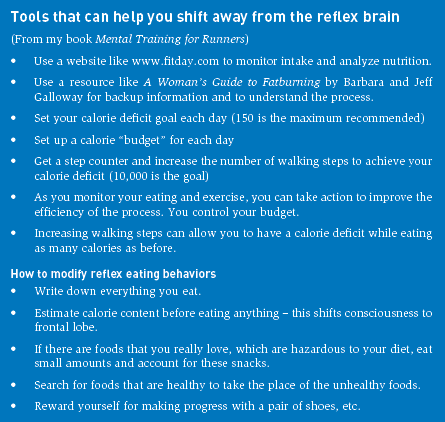
| 98 | I run to control my food intake |
We have many circuits inside the brain that trigger eating behaviors. If we don’t burn a certain threshold of calories each day, the hunger circuit is stimulated.
In the book Hardwired for Fitness, Drs. Portman and Ivy document how our brain monitors calorie burning. Surprisingly, regular physical activity helps to control appetite while sedentary behavior stimulates appetite. So if you want to keep from being hungry much of the time, keep moving. As noted in the sidebar below, reaching a threshold of calories burned each day coordinated the circuits that control hunger and energy.
Running gently, with walk breaks, is a great way to rev up your calorie burning. But if you run too hard, a significant amount of glycogen will be used. This storage form of carbohydrate is the brain’s reserve fuel source. If it is not replaced within 30 minutes of finishing a run, there will be some appetite increase.
The glycogen reloading switches are “on” within the first 30 minutes after finishing a run. Eating a reloading meal, as noted below, can reduce the hunger response.
Walking is another great way to burn the calories while reducing hunger. Little if any glycogen is burned when walking, reducing the hunger. The more steps taken, the more fat burned. You can insert segments of walking during sedentary periods of the day. This improves health while burning fat.
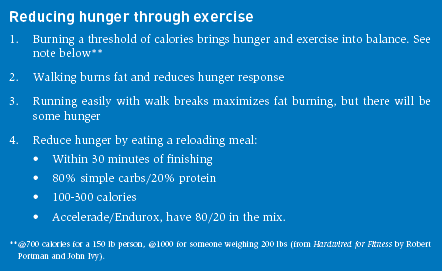
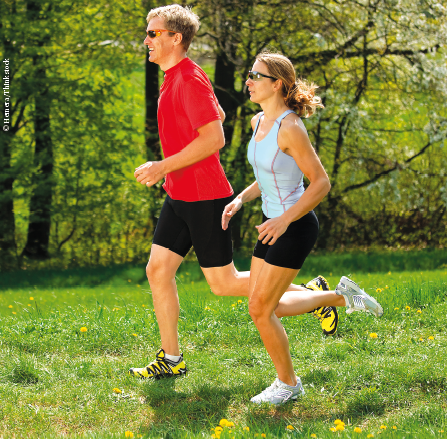
| 99 | I run so that I can burn off some fat |
Running is one of the best ways to burn fat and transform your muscle cells into fat burners over a 1-2 year period. By combining gentle running with purposeful eating and gentle walking, it’s possible to produce more lean body mass as you lower the fat percentage.
But many beginners get discouraged after the first few months because they don’t see a major drop in body weight. As your body adapts from sedentary life to endurance running, body weight (not fat) may temporarily increase with the addition of more blood plasma and greater storage of glycogen for energy. With every gram of additional glycogen, the body stores 4 grams of water. It is common for a runner to add 5-7 pounds so that the body can perform better physiologically.
The key training factors that promote fat burning are the following:
| 1. | Running a slow long run each week (with walk breaks) of at least 90 minutes. |
| 2. | Running two other runs of at least 60 minutes per week. |
| 3. | Walking a total of at least 10,000 steps a day. |
| 4. | Insertion of liberal walk breaks into every run. |
To burn fat, you must exercise aerobically. This means going at a slow enough pace so that the muscles are getting an adequate supply of oxygen, with no huffing and puffing.
When you run too fast, the muscles cannot get enough oxygen to burn fat and will shift to burning glycogen. This produces a high waste product, tight muscles as the workout continues, and significant huffing and puffing.
But if you don’t exercise control over the income side of the equation, weight will not be lost. There are several key factors that my wife Barbara has noted in our book A Woman’s Guide to Running/Fatburning. By conducting your eating behaviors in your frontal lobe, you can gain conscious control and burn it off!
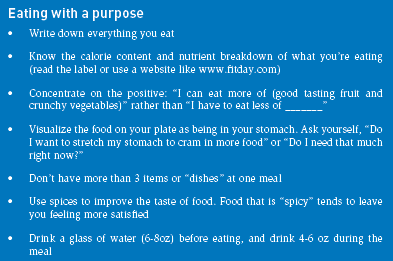
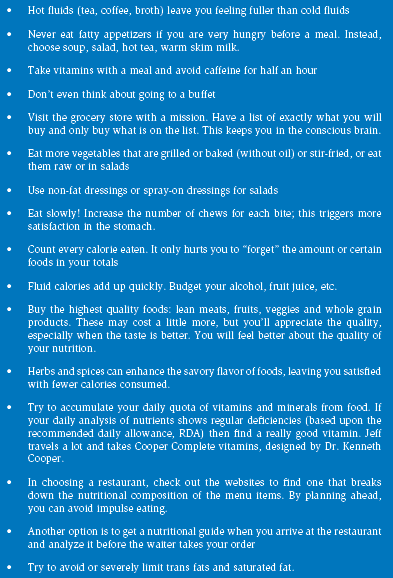
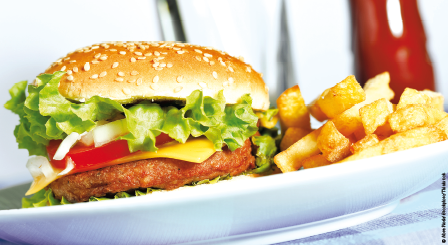
| 100 | I run to cut down on reflex eating |
Drs Portman and Ivy (Hardwired for Fitness) also explain how our appetite circuits were developed millions of years ago as our ancient ancestors developed coping mechanisms when food supply was constantly scarce.
A survival circuit evolved that kept the “feeling full” circuits from being activated long after our Paleolithic relatives had gorged themselves. The reflex brain kept triggering an subconscious eating pattern.
But this lack of feeling full enabled the ancients to survive. Those who ate large quantities when food was available established a fat reserve that kept them alive during periods of starvation. We have inherited this circuitry.
The simple act of writing down everything we eat has been shown to significantly reduce excess calories and calories from unhealthy food. This logging process gets you into the conscious brain so that you can control your eating activity.
Otherwise, we tend to respond to reflex eating behaviors based upon taste. Junk food makers know that combinations of sugar, salt, and fat can stimulate a powerful neurotransmitter called dopamine. This produces a substantial pleasure effect, and the subconscious brain triggers a reflex eating pattern. There’s no accountability. You can eat 20 potato chips or 200 without realizing how many.
Write it down
Account for it
Put it in your budget
